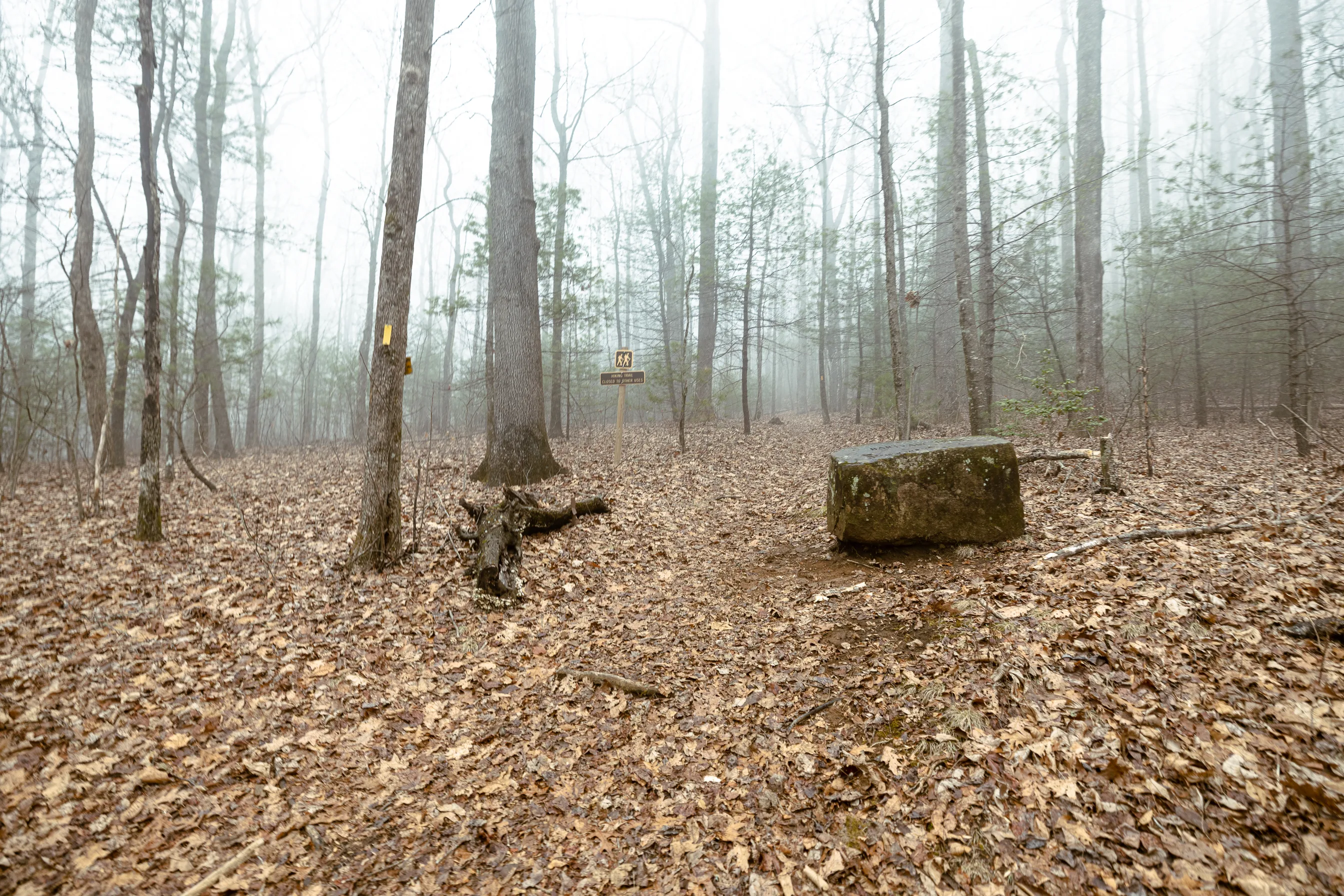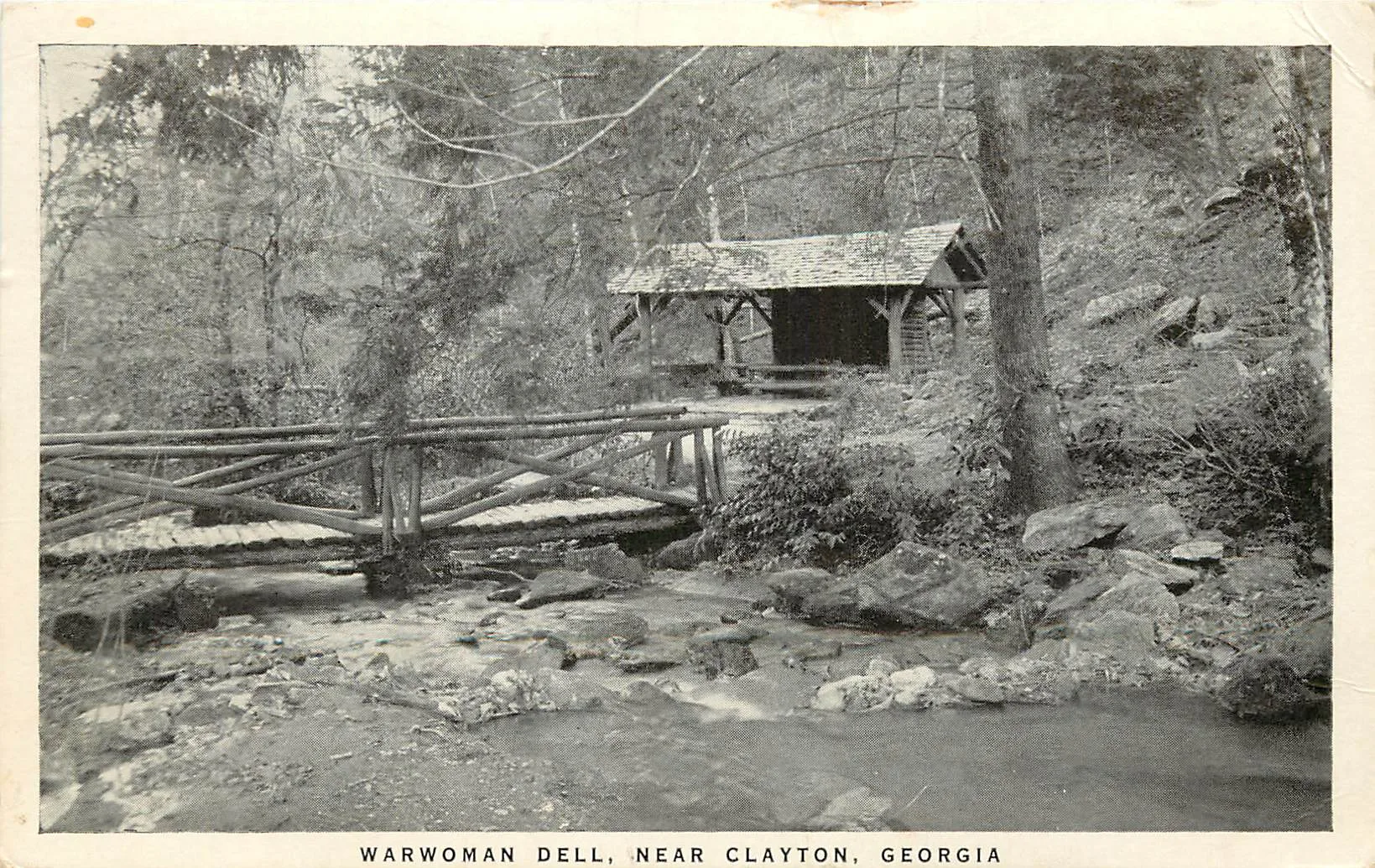
Section 3
Warwoman Dell to Wilson Gap

Warwoman Dell
34.8823, -83.3504
To access Warwoman Dell from Highway 441 in Clayton, travel east on Warwoman Road for three miles. A Forest Service sign will be on the right. The parking area on the left upon entry is just a few feet from where the Bartram Trail heads up Becky Branch. Hikers going towards Sandy Ford can drive on to the parking area at the end of the road. There is a composting privy there and a large pavilion with a fireplace, as well as an easy short loop trail to a waterfall and an interpretive kiosk.

From
William Bartram, Travels
"After passing through this meadow, the road led me over the bases of a ridge of hills, which as a bold promontory dividing the fields I had just passed for expansive green lawns. On these towering hills appeared the ruins of the ancient town of Stecoe. Here was a vast Indian mount or tumulus and great terrace, on which stood the council house, with banks encompassing their circus; here also were also old Peach and Plumb orchards, some of the trees appeared yet thriving and fruitful . . ."
Common FAQs
Nope!
Less experienced hikers might benefit from hiking more popular sections, where access is easier and where they might feel more comfortable knowing that there are other hikers close by to answer questions about logistics, trail conditions, and so on. Most of the major access points for the trail in North Carolina have informational kiosks.
Popular Sections/Trailheads include: Warwoman Dell, Wallace Branch, Little Tennessee River Greenway, Wayah Bald, & Appletree Campground
Whether planning a day hike on the Bartram Trail or an extended trip, consider your abilities for elevation gain and the associated distances, as these are two major factors in enjoying your hike. Many of the Bartram sections are also easier to travel north to south, as there is a general loss of elevation as one proceeds south, particularly in Georgia. Regardless, if you are not an experienced hiker, start with hikes under five miles, and check our website for information on trail conditions.
Short Answer: the best time to hike is anytime you can get away on the trail & anytime there is a weather forecast that doesn’t have dangerous conditions as a possibility.
Long Answer: Spring and Fall are the two seasons most pleasant for hiking, as well as the two seasons when wildflowers are the most spectacular. Depending on the section you’re hiking, hikers must prepare for stream crossings, steep elevation gains and losses, uneven and rocky terrain, lack of water, rapidly changing weather conditions, or all of the above. Temperatures are cooler at the higher elevations, and summer rains can leave a hiker chilled to the point of hypothermia if caught unprepared. Winter can include crisp, bright, warm days followed by subfreezing temperatures, snow, and/or ice. The Bartram Trail passes through a high rainfall area, with over 100 inches of rain in a year not uncommon. Choose a time and difficulty that will best suit what you are looking to gain/experience with your BT hike!
Practice the seven principles of Leave No Trace:
- Plan Ahead & Prepare: Includes reaching your destination, checking regulations, preparing for potential hazards, & packing appropriately.
- Travel & Camp on Durable Surfaces: Choose established trails and campsites, or areas that are already impacted, to avoid disturbing vegetation and fragile ecosystems.
- Dispose of Waste Properly: Pack out everything you pack in, including food scraps, toilet paper, and other trash. Human waste should be disposed of properly, away from water sources and campsites.
- Leave What You Find: Do not remove natural objects like rocks, plants, or artifacts. Leave the environment as you found it for others to enjoy.
- Minimize Campfire Impacts: Use existing fire rings or fire pans, keep fires small, and ensure fires are completely extinguished before leaving.
- Respect Wildlife: Observe wildlife from a distance, avoid disturbing their habitat, and do not feed animals.
- Be Considerate of Other Visitors: Respect other people's outdoor experiences by being mindful of noise levels, keeping a safe distance, and being courteous on trails.
HERE is a blog post that goes more in depth on having a safe trail experience. In short:
- Always follow the yellow blazes!
- Make sure you bring plenty of water and food for your journey.
- Have someone at home know where you are and how long you plan on being there.
- Purify your drinking water.
- Be aware of hunting season (typically from early autumn through February).
- Be prepared for wading stream sections and how rain can cause streams to swell quickly.
- Check Forest Service Websites for road closures.
- Bring enough supplies to last through an emergency.
- Prepare for the worst, hope for the best!
Yes, but it is advised to keep your pets leashed and under control. Bear, deer, coyotes, and many other animals share the forest that the Bartram trail passes through. A dog you think might be under your control but unleashed could take off after anything, and you might spend a long time trying to find it – and it could have had a bad encounter resulting in injuries or death. Also, it is respectable to other hikers who may not appreciate dogs, as well as other dog owners who keep their dogs leashed.
You can submit a trail story by emailing our Membership Development Coordinator, Fiona Howell. Her email is fiona@blueridgebartram.org. Make sure you include your name, any pictures & captions you want, and a story you are comfortable with us posting on our site and socials.
What you bring on a hike can differ greatly based on distance, topography, weather, and what your interests are for the experience. Check the weather! Some basic items for a short hike (2-4 miles) are a daypack with water, snacks, rain gear (even if there’s a slight chance), and a basic first aid kit. For a longer hike, be prepared for a change in weather (raingear, extra layer, extra socks).
Still have questions?
We're here to help!

Hiking Map of North Carolina’s Bartram Trail
$17.00

Hiking Map of Georgia’s Bartram Trail
$17.00
Stay in Touch
Subscribe to stay up-to-speed on trail news, upcoming events, merch drops, trail conditions, and more.



